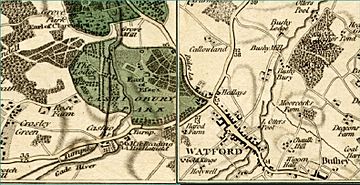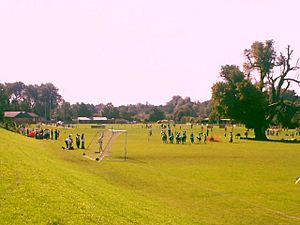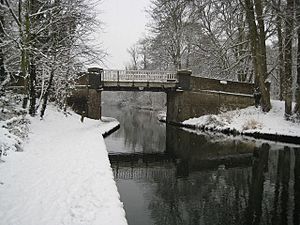Cassiobury Park facts for kids
Quick facts for kids Cassiobury Park |
|
|---|---|

Cassiobury Park
|
|
| Type | Public park |
| Location | Watford, Hertfordshire, England |
| Area | 190 acres (0.77 km2) |
| Operated by | Watford Borough Council |
| Status | Open year round |
Cassiobury Park is the main public park in Watford, Hertfordshire, England. It was opened in 1909. The park was created when Watford Borough Council bought land from the Earls of Essex. This land was part of their large estate around Cassiobury House, which was later taken down in 1927.
The park is very big, covering over 190 acres (0.77 km2). It stretches from Rickmansworth Road in the east to the Grand Union Canal in the west. It is located south of the Cassiobury area of Watford. A part of the western side is a special Local Nature Reserve. This area is looked after by the Herts and Middlesex Wildlife Trust. Every Saturday morning, the park hosts a free 5km running event called parkrun. It starts at 9 am near the Rickmansworth Road entrance.
Contents
History of Cassiobury Park
From Old Times to the 1800s
Long ago, in AD 793, King Offa gave the land where Cassiobury Park now stands to St Albans Abbey. This area was then known as the "manor of Cashio."
In 1539, Henry VIII took control of the monasteries. He then granted the land to Sir Richard Morrison in 1546. Sir Richard began building Cassiobury House, a large mansion. His son, Sir Charles Morrison, finished the house. It had 56 rooms, stables, and other buildings.
In 1627, the Capel family took over the estate through marriage. Arthur Capell, 1st Earl of Essex, had the house rebuilt around 1677–1680. Famous artists like Grinling Gibbons (a wood carver) and Antonio Verrio (a painter) helped make the inside beautiful. The gardens were designed by Moses Cooke, who created lovely woodland paths.
Later, other famous gardeners like George London and Charles Bridgeman also worked at Cassiobury. Between 1672 and 1720, nearly 300 lime trees were planted. These trees formed an avenue connecting the gardens to Whippendell Wood. You can still see some of these old trees today.
In the late 1700s, parts of the Grand Union Canal that ran through the property were made wider. This was because William Capell, 4th Earl of Essex, wanted it.
Around 1799–1805, the 5th Earl of Essex had the house redesigned in a Gothic style. Humphry Repton helped to improve the park's design. At this time, the park was about 693 acres (2.80 km2) big.
In 1841, a fire destroyed the orangery, which was a greenhouse filled with rare plants. Deer roamed freely in the park. People could ride and walk through the grounds, but they needed a ticket first.
The Park in the 1900s
George Capell, 7th Earl of Essex married a wealthy American woman. This helped him keep the estate going. Parties and events continued at Cassiobury House. In 1902, young Winston Churchill and King Edward VII even visited.
However, the Essex family decided to rent out the house and live in London. It was becoming too expensive to maintain. In 1909, 184 acres (0.74 km2) of the parkland were sold. Most of this land went to Watford Borough Council. They used it for building houses and for creating the public park we see today.
After the 7th Earl died in 1916, his wife and son sold the estate in 1922. They needed money to pay taxes. The house itself was taken down for its building materials in 1927. Watford Borough Council bought even more land for the public park in 1930.
New houses were built on the former parkland, creating the Cassiobury Estate. Only good quality detached or semi-detached houses were allowed. Most of this building happened in the 1930s.
On June 8, 1922, the Cassiobury Park estate was auctioned off. This included the mansion, other buildings, and the West Herts Golf Links. The whole area was about 870 acres (3.5 km2).
Since the house was not sold, it was demolished in 1927. Only the stable block remains today. It has been turned into Cassiobury Court, a home for older people. The grand staircase from the house was moved to the Metropolitan Museum of Art in New York. Other parts of the house were used to fix up Monmouth House in Watford High Street.
It is said that some of the stone from the old mansion was used to build a new Cassiobury House in Bedford, New York, in the United States.
In 1967, the old entrance gates on Rickmansworth Road were also taken down. This was to make way for a new road system.
Little Cassiobury, another house on the estate, still exists in Hempstead Road, Watford. It was sold separately. It was later bought by Hertfordshire County Council. They built Watford College (now West Herts College) on part of the site.
What's in a Name?
The name "Caegesho" was used for a larger area of land given by King Offa in 793. "Caeg" might have been a person's name. "Ho" means "a spur of land" in Old English. Over time, "Caegesho" became "Cassio."
The ending "-bury" is common in English place names. It comes from the Old English word "burh," which means "a fortified place" or "a fort." So, Cassiobury means something like "Cassio's fort" or "Cassio's manor."
Exploring the Park
Most of Cassiobury Park is covered with mown grass and scattered trees. You can find interesting trees like American oaks, including the pin oak and the scarlet oak. There are also beautiful cedar of Lebanon trees. Many new trees have been planted, such as swamp cypress and various Asian rowans.
The park gently slopes downhill from east to west. It leads into the valley of the River Gade. The winding river and its bridges make the park very charming. The Grand Union Canal also runs through the park, taking a more direct route. Both the river and canal flow from north to south. The River Gade flows into the River Colne, which then joins the River Thames.
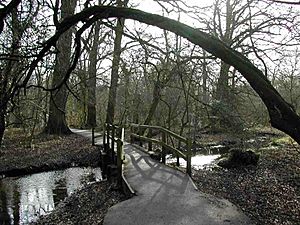
Some parts of the valley are wooded and can be wet. You can find alder trees growing beside the streams. Here, you might also see the remains of old beds where watercress used to grow.
Beyond the river and canal, the ground rises steeply to the West Herts Golf Course. Beyond that is Whippendell Wood. The whole area is open to everyone and feels very natural, even though it's close to London.
The park has several man-made features for visitors. These include paddling pools for kids and a miniature railway near the River Gade. There are also tennis courts, a bowling green, and paved paths for walking or cycling. The Watford Miniature Railway is 1010 yards long and uses both steam and diesel trains for passengers.
Animals and Plants
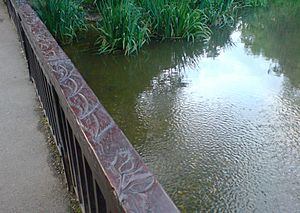
The birds you see in the main park areas are typical for parks in southern England. You might spot nuthatches near old trees, or redwings and fieldfares in open grassy areas. Gulls often gather in flocks near the lower parts of the River Gade.
The canal, river, and streams offer more interesting bird-watching opportunities. You might see teal, water rail, grey wagtail, grey heron, and kingfisher. When it's freezing, you might even find wading birds like snipe, redshank, and green sandpiper in the old cress-beds.
The valley is also a good place to see willow tit, reed bunting, and sedge warbler. Alder trees attract flocks of siskin and redpoll. The Lesser spotted woodpecker is also often seen here.
Some of the old ditches and nearby woodlands have become a local nature reserve. Here, you can find plants like marsh marigold and large beds of great reed-mace.
You might also notice three types of balsams growing by the riverside: small balsam, jewel-weed, and policeman's helmet. These plants are thought to have escaped from the canal wharves, where they arrived with imported wood.
Filming Location
Cassiobury Park has been used as a filming location for movies and TV shows. This is because it's close to big film studios like Elstree Studios.
In 1997, Whippendell Wood, which is next to the park, was used for a Star Wars movie. It became a forest on the planet Naboo in Star Wars: Episode I – The Phantom Menace. This is where Qui-Gon Jinn (Liam Neeson) and Obi-Wan Kenobi (Ewan McGregor) first meet Jar Jar Binks (Ahmed Best).
Images for kids



